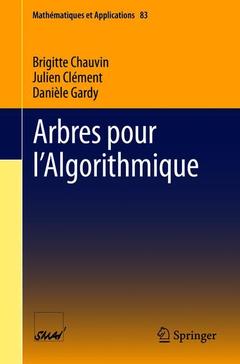Arbres pour l'Algorithmique, 1ère éd. 2018 Coll. Mathématiques et Applications, Vol. 83
Auteurs : Chauvin Brigitte, Clément Julien, Gardy Danièle

Introduction.- Partie I Modèles.- 1.Botanique.- 2.Aléa sur les arbres.- 3.Arbres, algorithmes et données.- Partie II Analyses.- 4.Approche combinatoire.- 5.Approche probabiliste.- 6.Arbres binaires de recherche.- 7.Arbres digitaux.- 8.Arbres m-aires et quadrants.- 9.Urnes de Pólya et applications.- A.Rappels algorithmiques.- B.Rappels mathématiques : combinatoire.- C.Rappels mathématiques : probabilités.- D.Un peu d’histoire.- E.Rappel des notations utilisées.- References.- Index.- Liste des auteurs.
positionnement équilibré entre l'informatique fondamentale et les mathématiques
nombreuses figures
pas de livre équivalent sur ce sujet, au niveau master, y compris en anglais
exercices à la fin de chaque chapitre
Date de parution : 03-2019
Ouvrage de 513 p.
15.5x23.5 cm
Disponible chez l'éditeur (délai d'approvisionnement : 15 jours).
Prix indicatif 58,01 €
Ajouter au panierThèmes d’Arbres pour l'Algorithmique :
Mots-clés :
Analyse en moyenne et en distribution; Arbres binaires de recherche; Arbres planaires; Arbres digitaux; Arbres quadrants; Tas; Urnes de Pólya; Processus de Galton-Watson; Marches aléatoires branchantes; Complexité en moyenne et en distribution; data structures; algorithm analysis and problem complexity; combinatorics



